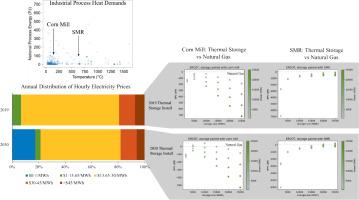Benchmarking thermal energy storage cost for industrial process heat
IF 11
1区 工程技术
Q1 ENERGY & FUELS
引用次数: 0
Abstract
Process heat accounts for roughly half of industrial energy demand, and currently 95 % of process heat is derived from the combustion of natural gas, oil, and coal. Electrification of industrial heating could be an alternative, potentially expanding locations suitable for manufacturing; however, industrial facility owners may desire energy storage to stabilize energy costs. In this work, the economic benefits of pairing thermal storage with electrified process heat to reduce the average price paid for energy are analyzed. Cost savings focus on energy arbitrage, or leveraging flexible energy pricing schemes, alone. The cost of natural gas combustion across decades (2019–2060) is compared to the costs of electricity and thermal energy storage in four United States Independent System Operator (ISO) regions. Systems installed today may not yield positive net present value (NPV) compared to the use of natural gas. However, using estimated electricity prices, systems installed in 2030 using arbitrage alone could be profitable when compared to natural gas in some regions of the U.S. Furthermore, if capital expenditures could be reduced by 50 % for sensible thermal storage systems by 2030, profitable systems are found across all regions. This implies that electrification of industrial process heat, when paired with inexpensive thermal energy storage systems, could be less expensive than brownfield natural gas systems, using arbitrage as the only source of revenue and without a dependency on any future policy drivers such as pricing externalities that could further incentivize the electrification of industrial process heat.

工业过程热的热能储存成本基准
过程热约占工业能源需求的一半,目前95%的过程热来自天然气、石油和煤的燃烧。工业供暖电气化可能是另一种选择,可能会扩大适合制造业的地点;然而,工业设施所有者可能希望能源储存来稳定能源成本。本文分析了蓄热与电气化过程热相结合以降低能源平均支付价格的经济效益。节约成本的重点是能源套利,或利用灵活的能源定价方案。将未来几十年(2019-2060年)的天然气燃烧成本与美国四个独立系统运营商(ISO)地区的电力和热能储存成本进行了比较。与使用天然气相比,目前安装的系统可能无法产生正的净现值(NPV)。然而,根据估计的电价,与美国一些地区的天然气相比,到2030年安装的仅使用套利的系统可能是有利可图的。此外,如果到2030年明智的储热系统的资本支出可以减少50%,那么所有地区都可以发现有利可图的系统。这意味着,当与廉价的热能储存系统相结合时,工业过程热的电气化可能比棕地天然气系统更便宜,使用套利作为唯一的收入来源,并且不依赖于任何未来的政策驱动因素,如定价外部性,这可能进一步激励工业过程热的电气化。
本文章由计算机程序翻译,如有差异,请以英文原文为准。
求助全文
约1分钟内获得全文
求助全文
来源期刊

Applied Energy
工程技术-工程:化工
CiteScore
21.20
自引率
10.70%
发文量
1830
审稿时长
41 days
期刊介绍:
Applied Energy serves as a platform for sharing innovations, research, development, and demonstrations in energy conversion, conservation, and sustainable energy systems. The journal covers topics such as optimal energy resource use, environmental pollutant mitigation, and energy process analysis. It welcomes original papers, review articles, technical notes, and letters to the editor. Authors are encouraged to submit manuscripts that bridge the gap between research, development, and implementation. The journal addresses a wide spectrum of topics, including fossil and renewable energy technologies, energy economics, and environmental impacts. Applied Energy also explores modeling and forecasting, conservation strategies, and the social and economic implications of energy policies, including climate change mitigation. It is complemented by the open-access journal Advances in Applied Energy.
 求助内容:
求助内容: 应助结果提醒方式:
应助结果提醒方式:


